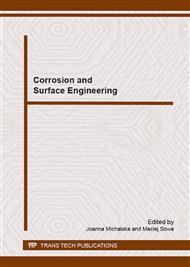[1]
H. Böhni, T. Suter, T. Schreyer, Electrochim. Acta 40 (1995) 1361–1368.
Google Scholar
[2]
T. Suter, H. Böhni, Electrochim. Acta 42 (1997) 3275–3280.
Google Scholar
[3]
M. M. Lohrengel, Electrochim. Acta 42 (1997) 3265–3271.
Google Scholar
[4]
A.W. Hassel, M.M. Lohrengel, Electrochim Acta 42 (1997) 3227–3333.
Google Scholar
[5]
T.Y. Liu, R.A. Boykins, Anal. Biochem. 182 (1989) 383–387.
Google Scholar
[6]
J.O. Park, C.H. Paik, R.C. Alkire, J. Electrochem. Soc. 143 (1996) L174–L176.
Google Scholar
[7]
P.T. Charles, J.G. Rangasammy, G.P. Anderson, T.C. Romanoski, A.W. Kusterbeck, Anal. Chim. Acta 525 (2004) 199–204.
Google Scholar
[8]
H. Krawiec, S. Stanek, V. Vignal, J. Lelito, J.S. Suchy, Corros. Sci. 53 (2011) 3108–3113.
DOI: 10.1016/j.corsci.2011.05.054
Google Scholar
[9]
H. Krawiec, V. Vignal, Z. Szkalarz, J. Solid Sate Electrochem. 13 (2009) 1181-1191.
Google Scholar
[10]
L. Staemmler, T. Suter, H. Böhni, J. Electrochem. Soc. 151 (2004) G734– G739.
Google Scholar
[11]
M.M. Lohrengel, A. Moehring, M. Pilaski, Electrochim. Acta 47 (2001) 137–141.
Google Scholar
[12]
M. Schneider, U. Langklotz, A. Michaelis, B. Arnold, Surf. Interface Anal. 42 (2010) 281–286.
DOI: 10.1002/sia.3175
Google Scholar
[13]
T. Suter, H. Böhni, Electrochim. Acta 47 (2001) 191–199.
Google Scholar
[14]
V. Vignal, H. Krawiec, O. Heintz, R. Oltra, , Electrochim. Acta 52 (2007) 4994–5001.
Google Scholar
[15]
L. Paussa, F. Andreatta, N.C.R. Navarro, A. Duran, L. Fedrizzi, Electrochim. Acta 70 (2012) 25–33.
Google Scholar
[16]
J.A.D. Rose, T. Suter, A. Balkowiec, J. Michalski, K.J. Kurzydlowski, P. Schmutz, Corros Sci 55 (2012) 313–325.
Google Scholar
[17]
O. Guseva, J. A. D. Rose, P. Schmutz, Electrochim Acta 88 (2013) 821–831.
Google Scholar
[18]
R.A. Perren, T.A. Suter, P.J. Uggowitzer, L. Weber, R. Magdowski, H. Böhni, M.O. Speidel, Corros. Sci. 43 (2001) 707–726.
DOI: 10.1016/s0010-938x(00)00087-1
Google Scholar
[19]
V. Vignal, D. Ba, H. Zhang, F. Herbst, S. LeManchet, Corros. Sci. 68 (2013) 275-278.
Google Scholar
[20]
H. Krawiec, J. Lelito, E. Tyrała, J. Banaś, J. Solid State Electrochem. 13 (2009) 935–942.
DOI: 10.1007/s10008-008-0636-x
Google Scholar
[21]
H. Krawiec, V. Vignal, J. Banaś, J. Electrochem. Soc. 153 (2006) B231-B237.
Google Scholar
[22]
M. Sanchez, N. Aouina, D. Rose, P. Rousseau, H. Takenouti, V. Vivier, Electrochim. Acta 62 (2012) 276–281.
Google Scholar
[23]
F. Arjmand, A. Adriaens, Electrochim. Acta 59 (2012) 222–227.
Google Scholar
[24]
J.B. Jorcin, H. Krawiec, N. Pebere, V. Vignal, Electrochim. Acta 54 (2009) 5775–5781.
Google Scholar


